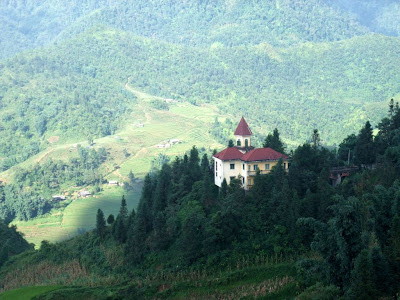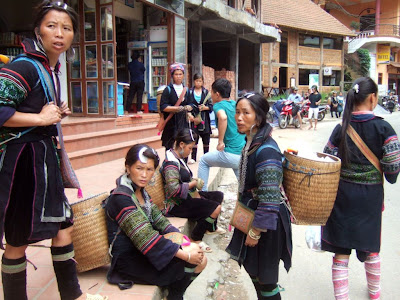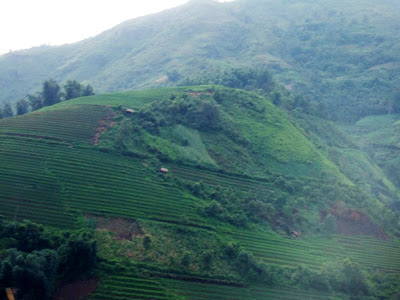
Sapa is an incredibly picturesque town locating 1650 meter above sea level, near China Border at north west side of Vietnam. It lies in Hoang Lieu Son Mountain Ranges that are usually known as The Tonkinese Alps. Sapa is very famous for its fine and rugged scenery as well as its rich cultural diversity.



Among Hoang Lieu Son Mountain Ranges, Fansipan Mountain is the highest peak in Vietnam. With height 3143 meter, it is covered with clouds all year round and it seems like no one ever has an opportunity to view its true look.


Sapa and its surrounding region is host to many hill tribes, areas of rice terraces, and lush vegetation.



View of Hoang Lieu Son Mountain Ranges in a glorious clear day. We were indeed quite fortunate to capture this scenery.



Weather of Sapa Town is invariably cold, wet and foggy. Tourists sometimes are quite easily trapped in impenetrable fog.



Glorious vistas sometimes may be completely hidden in the mist.




Watching the volatile clouds over Fansipan Mountain from the top floor cafe restaurant of an hotel.


The Catholic Church, The Square and Town Hall are colonial buildings left by French Colonialists. The Cathedral was built in stone in 1930.



There are 8 different ethnic minorities live in and around Sapa. The whole population of the district total up is about 32,000 people and only 10% of them live in Sapa Town, majority of them are peasant farmers distributed unevenly throughout the district. Accordingly to statistic, half of the 8 ethnic minorities remain less than a total of 500 people only.



Many female of ethnic minorities, especially old aged women, make items such as ethnic-style clothes and blankets to sell to tourists.



Besides aged women, children particular girls, also begin to support families in finance as young as 5-6 years old.



Tourists are encouraged to get some hand made items direct from the ethnic minorities even though their price is higher than the shops, as this is also one of the ways to assist them in surviving.


A great number of ethnic minorities women walk for several hours from their surrounding villages to reach the town each day, looking for luck from tourist to purchase their own-made products.


They peddle small metal or silver trinkets, embroidered pillow cases or friendship bands in the main street of Sapa Town. They depend very much on tourist's money to survive. Without a sale, they may sometimes have a meal only. By the end of the day, some take a motorbike ride back to their village, some walk home and some sleep in the market.



The girls usually marry early at an age between 15-18 years old and always by the age of 20, they already become a mother of 2-3 children. Majority of their families are rather poor, they have no choice but walking miles and miles just to do some little sale in the town, in order to help the families.



The males are mostly peasant farmers, taking care of rice fields and vegetation.



Whenever there is a tourist around, all women will rush forth and follow behind him to walk for miles after miles, patiently waiting to conclude just a few dollar's sale.





Striking up a conversation with them could be very interesting and many of tourists are really impressed by their fluency in speaking English.



At a result of recent surge in popularity, Sapa has reapidly become a tourist hotspot where money is the new drug of choice. Some smart Ethnic minority begin to go into business. The shop by the end lot of Sapa main street is operated by Hmong Ethnic minority tribe.



Exquisite shops of Romano's Pizza and Nomadtrails travel office along the main street of Sapa Town.


With all these elegant furnished restaurants, Sapa Main Street makes you feel more like in a small place in Western country than in an oriental place at Vietnam.



Besides Romano's Pizza, there are also quite a number of Western restaurants along the main street, offering Western food as well as Sapa local cuisine.



The cozy Fansipan Restaurant and Bar is just next to Romano's Pizza.


A local wet market of Sapa, supplying abundant local fresh fruits, vegetables and groceries. At the space by the side of the dim narrow wet pathway, there are many kind of shops selling stuff for locals needs and traveling related items for tourists, like bags, shoes, attire etc. There are also a lot of food stalls offering varieties of interesting local food inside the market.


The most useful and commonly used food carriers in Sapa are these handmade baskets.


Flowers, almond and green apples are some of the local produces.



A little cozy hotel at the foot of Ham Rong resort mountain, operated by an energetic New Zealand graduated young man, with his pretty wife.



A beautiful old colonial building!


The gorgeous home has converted into home-stay accommodation suit, offering personal services to make foreign guests stay like home. It is monitored by a young man with assistance from parents.



Splendid landscape, especially the central resting pavilion. All were designed and taken care by owner personally. He was graduated in New Zealand.



There is a man-made pond, wild orchid farm and small vegetation at the back yard.



French guests enjoyed home-cooked meals.


Home stay! Owner's lovely daughter and his mother who is responsible in cooking for all its guests.



Enjoy an hour of beautiful view when riding on a shuttle bus from Lao Cai to Sapa. The train from Hanoi ends at Lao Cai and visitors have to change to shuttle buses available outside the station for the remaining distance to Sapa.


Such scenery exists only when weather is good. Very often the one hour journey from Lao Cai to Sapa are greeted with fog.






The 38km scenic way between Lao Cai and Sapa Town




Sapa, a notable hill resort.



Lao Cai literally means old street. Lao Cai and Sapa are two important cities in northwest of Vietnam at the border with China. Lai Cai shares the border with City of Hekou in Yunnan of China and has been well known since ancient times, as a historic trading post. It is a melting pot of culture and history as within its more than half million population, about 65 percent are more than 20 different groups of ethnic minority.


From Hanoi to Sapa, the train journey takes about 9 hours. There is only one trip a day, leaving Hanoi at night, and ends at Lai Cai early morning, The train is run by Vietnam Rail but some of the coaches in the train are operated by private company, which of course are more expensive (about 25-30 US dollars one way) but significantly nicer than the standard ones.


There are many shuttle buses outside Lao Cai Train Station to service customers who are going to Saba Town. Lao Cai is one of the few mountainous town with well developed transport networks consisting of roads, rails and waterways, connecting with Hanoi as well as Yunnan of China.


No comments:
Post a Comment